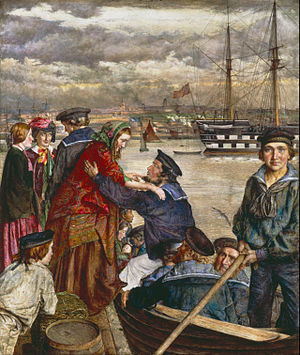
Willem van de Velde the Elder was a Dutch Golden Age seascape painter, who produced many precise drawings of ships and ink paintings of fleets, but later learned to use oil paints like his son.

Philip James de Loutherbourg RA, whose name is sometimes given in the French form of Philippe-Jacques, the German form of Philipp Jakob, or with the English-language epithet of the Younger, was a French-born British painter who became known for his large naval works, his elaborate set designs for London theatres, and his invention of a mechanical theatre called the "Eidophusikon". He also had an interest in faith-healing and the occult, and was a companion of the confidence-trickster Alessandro Cagliostro.

William Daniell (1769–1837) was an English landscape and marine painter, and printmaker, notable for his work in aquatint. He travelled extensively in India in the company of his uncle Thomas Daniell, with whom he collaborated on one of the finest illustrated works of the period – Oriental Scenery. He later travelled around the coastline of Britain to paint watercolours for the equally ambitious book A Voyage Round Great Britain. His work was exhibited at the Royal Academy and the British Institution and he became a Royal Academician in 1822.

Nicholas Pocock was an English artist known for his many detailed paintings of naval battles during the age of sail.
Events from the year 1793 in art.

Robert Salmon was a maritime artist, active in both England and America. Salmon completed nearly 1,000 paintings, all save one of maritime scenes or seascapes. He is widely considered the Father of American Luminism.
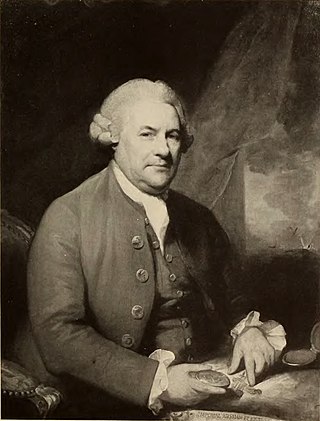
Richard Paton was a British marine painter.
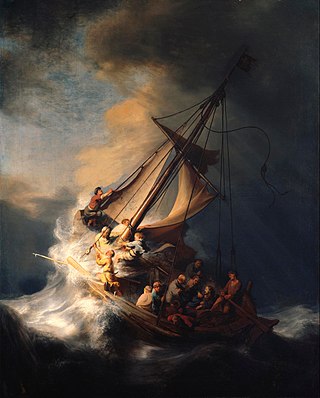
Marine art or maritime art is a form of figurative art that portrays or draws its main inspiration from the sea. Maritime painting is a genre that depicts ships and the sea—a genre particularly strong from the 17th to 19th centuries. In practice the term often covers art showing shipping on rivers and estuaries, beach scenes and all art showing boats, without any rigid distinction - for practical reasons subjects that can be drawn or painted from dry land in fact feature strongly in the genre. Strictly speaking "maritime art" should always include some element of human seafaring, whereas "marine art" would also include pure seascapes with no human element, though this distinction may not be observed in practice.

Jan Porcellis was a Dutch marine artist in the seventeenth century. His works initiated a "decisive transition from early realism to the tonal phase", fostering a new style and subject in marine painting by focusing on overcast skies and rough waters, a radical break from maritime art's previous focus on the grandeur of ships in historical settings. This style of greater simplicity surrounding maritime art, with the majority of the canvas displaying sea and sky, set the grounds for later works in this genre.
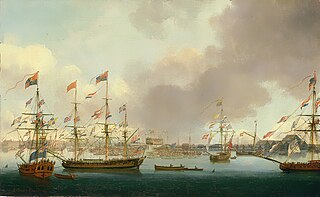
John Cleveley the Younger was a British artist and marine painter.

Antonio Nicolo Gasparo Jacobsen was a Danish-born American maritime artist known as the "Audubon of Steam Vessels".
Thomas Whitcombe was a prominent British maritime painter of the Napoleonic Wars. Among his work are over 150 actions of the Royal Navy, and he exhibited at the Royal Academy, the British Institution and the Royal Society of British Artists. His pictures are highly sought after today.

Realism in the arts is generally the attempt to represent subject matter truthfully, without artificiality and avoiding speculative and supernatural elements. The term is often used interchangeably with naturalism, although these terms are not synonymous. Naturalism, as an idea relating to visual representation in Western art, seeks to depict objects with the least possible amount of distortion and is tied to the development of linear perspective and illusionism in Renaissance Europe. Realism, while predicated upon naturalistic representation and a departure from the idealization of earlier academic art, often refers to a specific art historical movement that originated in France in the aftermath of the French Revolution of 1848. With artists like Gustave Courbet capitalizing on the mundane, ugly or sordid, realism was motivated by the renewed interest in the common man and the rise of leftist politics. The realist painters rejected Romanticism, which had come to dominate French literature and art, with roots in the late 18th century.

Isaac Sailmaker was an etcher and marine painter of the Baroque period, who had a long career in England. He was referred to in contemporary books and journals as "the father of British sea painting", but was eclipsed by his contemporaries, the Dutch marine painters Willem van de Velde the Elder and his son Willem van de Velde the Younger, who for a period dominated the London market. Sailmaker was commissioned by the English Lord Protector, Oliver Cromwell, to paint the English fleet at Fort-Mardyck.
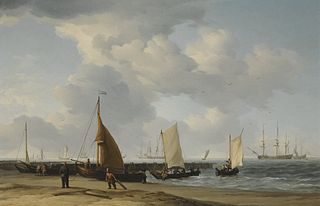
Charles Brooking (c.1723–59) was an English painter of marine scenes.

Laureys a Castro or Lorenzo a Castro was a Flemish painter of marine views and portraits who is mainly known for his work carried out in England roughly between 1672 and 1700. He was clearly regarded as a leading marine painter in England as many of his works were held in English collections.
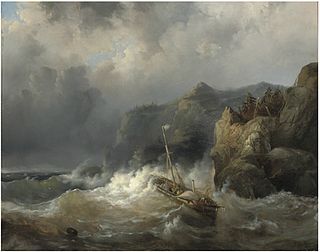
Egide Linnig or Egidius Linnig was a Belgian painter, draughtsman and engraver who is best known for his marine art and occasional genre scenes. He was one of the first realist engravers in Belgium.

Fishermen at Sea, sometimes known as the Cholmeley Sea Piece, is an early oil painting by English artist J. M. W. Turner. It was exhibited at the Royal Academy in 1796 and has been owned by the Tate Gallery since 1972. It was the first oil painting by Turner to be exhibited at the Royal Academy. It was praised by contemporary critics and burnished Turner's reputation, both as an oil painter and as a painter of maritime scenes.

George Ropes Jr. (1788–1819) was an American artist, known for his maritime oil paintings.

George Webster was a 19th-century British Marine Art painter. He toured extensively and painted seascapes of the places he visited. His work was exhibited at the Royal Society of British Artists and the Royal Academy.
Seaport Museum, 1982. Print.
1974. Print.
1924. Print.
University Press, 2003. Print.
University Press, 2007. Print.

